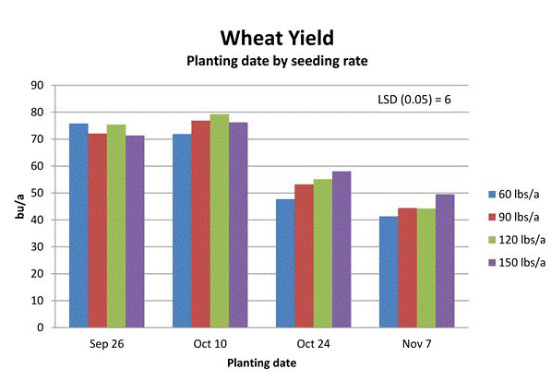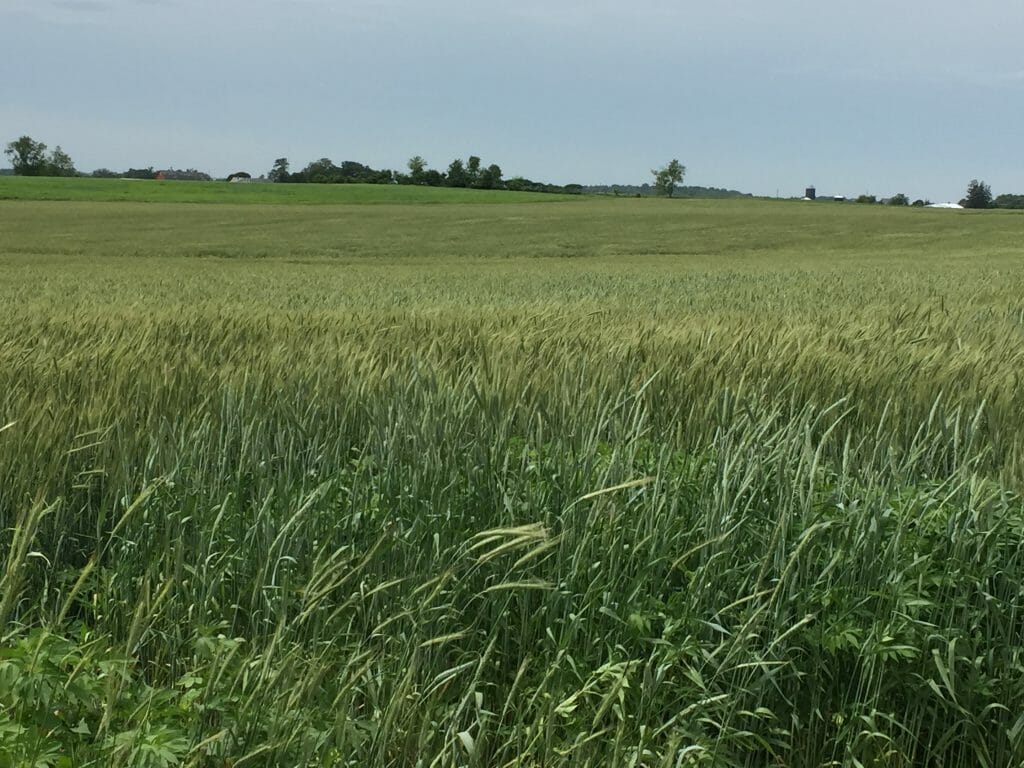Delayed Planting for Winter Small Grains
A brief glimmer of hope for early corn and soybean harvest in Iowa in 2018 and 2019 was doused in torrential rains through the end of September and early October. Not only does this affect corn and soybean quality, but it also prevented farmers from planting a winter small grain by the optimal seeding date of October 1-10. This leaves farmers to weigh the pros and cons of planting late versus substituting another crop altogether, this blog summarizes the yield loss expected from different late planting dates and management practices to optimize small grain performance under delayed planting conditions.
Yield Loss by Planting Date
If you’re unable to plant by October 10, small grain plants have less time to develop their crowns and store nutrients before the long cold winter sets in. This can result in reduced yields and less winter-hardiness. How much yield are you giving up? One study from Kansas reported on yields for winter wheat planted on the first of the month from October through March over seven years and they found the following reductions in yields corresponding to each month:
| Winter Wheat Planting Date | Yield Potential |
| October 1 | 100% |
| November 1 | 77% |
| December 1 | 59% |
| January 1 | 57% |
| February 1 | 41% |
| March 1 | 16% |
If you determine that this yield loss is unacceptable to you, you may choose to forgo a fall small grain planting and instead plant a spring small grain such as oats, barley or spring wheat.
Increase Seeding Rate to Mitigate Yield Loss
If you decide to proceed with planting a winter small grain, increasing your seeding rate can mitigate the effect of the late planting dates on yield. Nebraska extension, provides the simplest rule of thumb of an addition of 10-15 lbs of seed or 150,000-225,000 seeds per week that planting is delayed. The maximum suggested seeding rate for winter wheat is 120 lbs, any wheat planted in the second half of October should be planted at 90-120 lbs per acre or 1.35 million to 1.8 million seeds per acre and some data suggests a seeding rate of 150 lbs/acre will increase yields even farther at a late planting date.

Yield results of study of four seeding rates and four seeding dates conducted by Kansas State University in Northwest Kansas where the optimum seeding date is September 26. From: https://www.nebraskafarmer.com/wheat/delayed-wheat-seeding-heres-how-compensate
If you’re working with cereal rye or triticale, blanket recommendations are few and far between so you’ll have to do a little math to determine your delayed planting seeding rate for these crops. University of Minnesota reports that an optimum stand of winter small grains is 900,000 to 1,000,000 plants per acre or 21-23 plants per square foot under normal planting conditions. When planting is delayed, seeding rate should be increased to 23-25 plants per square foot or 1,001,880 to 1,089,000 plants per acre.
Remember when calculating your planting rates, to account for germination and stand loss. The 23-25 plants per square foot is based on live plants. You can use the following equation to determine your optimal seeding rate that accounts for germination and expected stand loss:
Seeding rate (pounds per acre) = [Plants per acre/(Germination – Stand Loss 10%)] / Seeds per lb
So if your seed tag says that you have a 95% germ rate and 15,000 seeds/lb and you have a late planting date so you’re shooting for 25 plants/square foot or 1,089,000 plants/acre you can plug those numbers into the equation. Taking 1,089,000 plants per acre divided by our combined loss to germination and stand loss 0.95 – 0.10 = 0.85 gives us 1,281,176.5 seeds needed per acre to achieve our target density of plants. Dividing this by the seeds per lb of 15,000 from the seed tag gives us 85.4 lbs per acre seeding rate.
85.4 lbs/acre seeding rate = [1,089,000/(.95-.1)] / 15,000
Other management strategies you can use to mitigate yield loss are using narrow row spacing of 7-8” instead of 10-15” rows. This can be achieved by running over the field twice with the 10-15” drill at a slight angle with one half the seeding rate. However, this only works with disk drills – planters and drills with higher disturbance (i.e. hoe drill) can bury much of the seed from the first pass too deep for even emergence. You might also consider apply phosphorous fertilizer on the planter or mixed with the seed. You can read more about how much fertilizer to apply and what forms here.
And don’t forget to consider your goals. If your focus is on forage rather than grain yield, a late planting date isn’t as much of a concern because impact on biomass/forage yield is less than grain yield. For grain growers, with some simple adjustments to management most yield loss associated with planting before November 1 can be mitigated to keep yields at 70% or higher. If you’re planting into November, yield losses start to approach 50% and warrant more consideration of switching to a spring small grain.
Want to get topical updates on small grains management like this straight to your email inbox? Sign up for our monthly small grains e-newsletter by emailing alisha@practicalfarmers.org.


